minnesota
 As the pioneers headed west, there were various disputes over ownership of the lands they were settling into. The Native American people did not think that they should have to surrender their lands to the White Man, but it seemed that they had no choice. Still, there were some Native Americans who refused to be pushed around by the government. On August 17, 1862, violence erupted in Minnesota as desperate Dakota Indians attacked white settlements along the Minnesota River. This was a fight that the Dakota Indians would eventually lose. They were no match for the US military, and six weeks later, it was over.
As the pioneers headed west, there were various disputes over ownership of the lands they were settling into. The Native American people did not think that they should have to surrender their lands to the White Man, but it seemed that they had no choice. Still, there were some Native Americans who refused to be pushed around by the government. On August 17, 1862, violence erupted in Minnesota as desperate Dakota Indians attacked white settlements along the Minnesota River. This was a fight that the Dakota Indians would eventually lose. They were no match for the US military, and six weeks later, it was over.
The Dakota Indians were often referred to as the Sioux, which I did not know was a derogatory name derived from part of a French word meaning “little snake.” It almost makes it seem like they were talking badly about them to their face, but so they couldn’t understand it. The government treated the Dakota poorly, and the Dakota saw their hunting lands dwindling 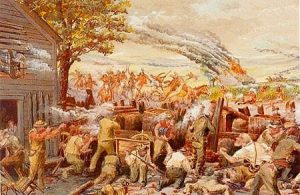 down, and apparently the provisions that the government promised to supply, rarely arrived. And now, to top it off, a wave of white settlers surrounded them too. To make matters worse, the summer of 1862 had been a harsh one, and cutworms had destroyed much of the crops. The Dakota were starving.
down, and apparently the provisions that the government promised to supply, rarely arrived. And now, to top it off, a wave of white settlers surrounded them too. To make matters worse, the summer of 1862 had been a harsh one, and cutworms had destroyed much of the crops. The Dakota were starving.
On August 17, the situation exploded when four young Dakota warriors returning from an unsuccessful hunt, stopped to steal some eggs from a white settlement. The were caught and they picked a fight with the hen’s owner. The encounter turned tragic when the Dakotas killed five members of the family. Now, the Dakota knew that they would be attacked. Dakota leaders, knew that war was at hand, so they seized the initiative. Led by Taoyateduta, also known as Little Crow, the Dakota attacked local agencies and the settlement of New 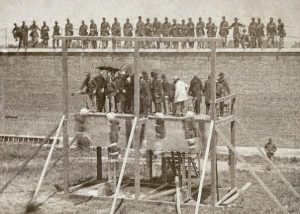 Ulm. Over 500 white settlers lost their lives along with about 150 Dakota warriors.
Ulm. Over 500 white settlers lost their lives along with about 150 Dakota warriors.
President Abraham Lincoln dispatched General John Pope, fresh from his defeat at the Second Battle of Bull Run, Virginia. Pope was to organize the Military Department of the Northwest. Some of the Dakota immediately fled Minnesota for North Dakota, but more than 2,000 were rounded up and over 300 warriors were sentenced to death. President Lincoln commuted most of their sentences, but on December 26, 1862, 38 Dakota men were executed at Mankato, Minnesota. It was the largest mass execution in American history, and it was all because they were starving, and had no hope of living through that year.

 Every wildfire takes with it many victims. Humans, of course, are the most tragic, but they also take animals, homes, and plant life. When a fire gets out of control, devastation will soon follow. Often, all we think about is the loss, and that is a terrible thing, but sometimes something happens that brings a degree of victory and elation to an otherwise horrible situation. Such was the case in the September 1, 1894 Hinckley, Minnesota fire. The loss of life was devastating, with some accounts saying 440 and others saying 418…partly because the Indians weren’t counted in that amount, and partly because there were people who were never found.
Every wildfire takes with it many victims. Humans, of course, are the most tragic, but they also take animals, homes, and plant life. When a fire gets out of control, devastation will soon follow. Often, all we think about is the loss, and that is a terrible thing, but sometimes something happens that brings a degree of victory and elation to an otherwise horrible situation. Such was the case in the September 1, 1894 Hinckley, Minnesota fire. The loss of life was devastating, with some accounts saying 440 and others saying 418…partly because the Indians weren’t counted in that amount, and partly because there were people who were never found.
The upper Midwest of the United States was a wooded area, rich in timber. Hinckley was a lumber and rail town, that had been built along the Grindstone River in Minnesota near the Wisconsin border. The main industry was the lumber business, and the slash cutting technique left behind it large amounts of wood debris. The town was nicknamed The Town Built Of Wood. Little did they know what a tragic nickname that would turn out to be. The lumber yards were built quite close to the railroad tracks, and the sparks from the 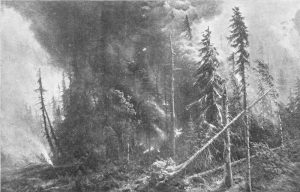 trains often set the wood debris on fire. Those fires were problematic, but no one expected the part the trains would play in 1894. That summer, a drought hit the Upper Midwest, making fires much more dangerous. The whole situation exploded on September 1, 1894, when fires near two rail lines south of Hinckley broke out, spreading north. When the raging fire reached the train depot, 350 of the residents got on a train to escape. The train passed right through flames, but reached safety in West Superior, Wisconsin. Were it not for this train, the loss of life would have been much higher. A number of the town’s residents took refuge in the swamps near town, but many of these people were killed, sadly some of them died by drowning. About 100 other residents fled to a gravel pit filled with water, and most of those people managed to survive. A train that was entering Hinckley from the north reversed direction to avoid the blaze. It still caught fire, and the only survivors were those who were able to jump from the train into a lake.
trains often set the wood debris on fire. Those fires were problematic, but no one expected the part the trains would play in 1894. That summer, a drought hit the Upper Midwest, making fires much more dangerous. The whole situation exploded on September 1, 1894, when fires near two rail lines south of Hinckley broke out, spreading north. When the raging fire reached the train depot, 350 of the residents got on a train to escape. The train passed right through flames, but reached safety in West Superior, Wisconsin. Were it not for this train, the loss of life would have been much higher. A number of the town’s residents took refuge in the swamps near town, but many of these people were killed, sadly some of them died by drowning. About 100 other residents fled to a gravel pit filled with water, and most of those people managed to survive. A train that was entering Hinckley from the north reversed direction to avoid the blaze. It still caught fire, and the only survivors were those who were able to jump from the train into a lake.
The fire burned 300,000 acres of town and forest, causing about $25 million in damages. In Hinckley, 228 people died, and another 200 in the surrounding areas, including 23 Ojibwa natives. It was a firestorm, with “as much force as an atomic bomb,” to quote a display at the town museum. Hinckley’s afternoon inferno also burned burned up five surrounding villages as it consumed over 400 square miles of kindling. It became known as the Great Hinckley Fire. A small group of statues in town represents survivors in the gravel pit. The Fire Monument and mass grave is on Fire Monument Road, very near the current interstate. Mass graves of 248 people are 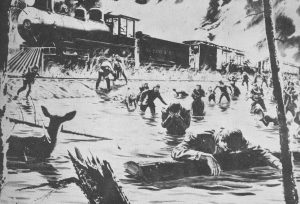
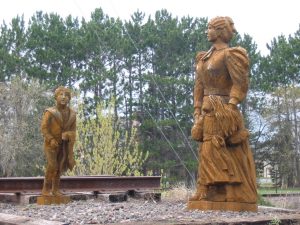 in lumpy mounds just behind the marker, dedicated in 1900 to the pioneers of civilization in Minnesota. Boston Corbett, killer of Abe Lincoln’s killer, is said to have left his “hole-in-the-ground home” in Kansas and died in the Great Hinckley Fire, in the neighboring town of Neodesha. The town of Hinckley has decided that the nickname The Town Built Of Wood is not one they want anymore, and their current slogan is “Relax…Have Fun!”
in lumpy mounds just behind the marker, dedicated in 1900 to the pioneers of civilization in Minnesota. Boston Corbett, killer of Abe Lincoln’s killer, is said to have left his “hole-in-the-ground home” in Kansas and died in the Great Hinckley Fire, in the neighboring town of Neodesha. The town of Hinckley has decided that the nickname The Town Built Of Wood is not one they want anymore, and their current slogan is “Relax…Have Fun!”
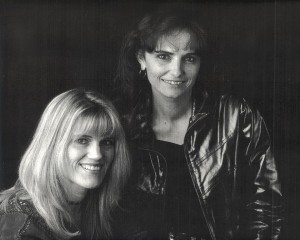 It all started in the late 1990s, in church. That was when two girls, my cousin, Julie Carlson Soukup and her friend, Melody Cox sang together, and found out that they had a God given musical bond. They found that Julie’s words combined with and complimented Melody’s music. Before long they had put together enough songs to record an album. In 1999, Crush Girls was born when the girls recorded their first album, Broken Dove, at Inland Sea Studios in nearby Superior, Wisconsin.
It all started in the late 1990s, in church. That was when two girls, my cousin, Julie Carlson Soukup and her friend, Melody Cox sang together, and found out that they had a God given musical bond. They found that Julie’s words combined with and complimented Melody’s music. Before long they had put together enough songs to record an album. In 1999, Crush Girls was born when the girls recorded their first album, Broken Dove, at Inland Sea Studios in nearby Superior, Wisconsin.
Julie and Melody knew that they had something special, but that’s not enough to grab the attention of the masses. For that you have to be extraordinary. That’s what Julie and Melody were…extraordinary. Before long Crush Girls had built a level of notoriety that allowed them to perform “some very cool gigs” as Melody would say. They played for the Governor of Minnesota, Jesse Ventura and his staff in a formal setting, and then the staff stayed to continue to enjoy the music around a campfire after the governor and his wife went to bed. They played during 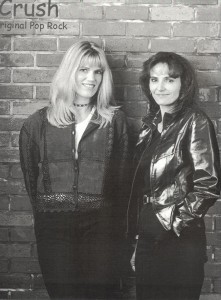 the Blue Angels Show in Duluth, Minnesota, the Harley Davidson Multiple Sclerosis Charity, and the Great American Heartwalk. They had a standing engagement as the house concert group for several months at Giant’s Ridge Golf and Ski Resort, as well as well as regular engagements around the Duluth area, including the Homegrown Festival. Their music continued to grow, and the girls recorded a couple of demos back at the Inland Sea Studios, including headlining song Candy Kisses, which became a crowd favorite.
the Blue Angels Show in Duluth, Minnesota, the Harley Davidson Multiple Sclerosis Charity, and the Great American Heartwalk. They had a standing engagement as the house concert group for several months at Giant’s Ridge Golf and Ski Resort, as well as well as regular engagements around the Duluth area, including the Homegrown Festival. Their music continued to grow, and the girls recorded a couple of demos back at the Inland Sea Studios, including headlining song Candy Kisses, which became a crowd favorite.
As with most things, time stepped in and the girls’ took different paths for a time…a time which Melody called “Crush, the Dark Years.” Nevertheless, she says that Julie and their music were certainly never far from her mind. Melody missed Julie and their musical “children.” She continued to play gigs and always included songs from Crush Girls in the set list. Then, time stepped in again and the music resonated in Julie again. The girls reconnected and have been writing again, but on a deeper and more sincere level. The girls still live a few hundred miles apart…Julie in Duluth, Minnesota and Melody in Asheville, North Carolina, but Melody says that Julie will always be her heart’s twin, with the first cut of their Broken Dove album, I Begin In You as their core. She truly believes that their music will continue and will find a way, and I think determination will bring it to pass.

I tend to agree with Melody, because I don’t think Crush Girls are over. Their latest song, Shores Evermore is the expression of the music finding a way. They are making plans to take some time to step back into the studio. As Melody says, “Much more is stirring in the Crush breeze! So stay tuned ~ more Crush songs are coming!” Having taken the time to listen to some of their songs, I can tell you that each and every one is worth waiting for. I think God certainly knew what He was doing when He joined these two musical hearts together. I hope they will indeed find a way to make more of their music, because I think a lot of people would really enjoy it if they did.
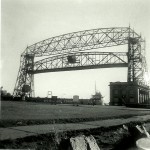 Because I was born in Superior, Wisconsin, located at the tip of Lake Superior, and across the bridge from Duluth, Minnesota, I am interested in all things that have to do with that area. My family moved to Casper, Wyoming when I was three, so I was not raised in that area, but somehow, it is in my blood. I will always have roots I can feel there. We still have a large number of family members there, and we continue to get to know them more and more due to a trip back there, and continued connections on Facebook. For that family we are very grateful, because they are all amazing.
Because I was born in Superior, Wisconsin, located at the tip of Lake Superior, and across the bridge from Duluth, Minnesota, I am interested in all things that have to do with that area. My family moved to Casper, Wyoming when I was three, so I was not raised in that area, but somehow, it is in my blood. I will always have roots I can feel there. We still have a large number of family members there, and we continue to get to know them more and more due to a trip back there, and continued connections on Facebook. For that family we are very grateful, because they are all amazing.
As I said, I love the area around Lake Superior, and the shipping business that comes through there is an amazing thing to watch. In order for shipping to thrive on Lake Superior, they had to have a way to get the big oar boats and other large ships into the port. In 1892, a contest was held to find a solution for the transportation needs to go from Minnesota Point to the other side of the canal that was dug in 1871. a man named John Low Waddell came up with the winning design for a high rise vertical lift bridge. The city of Duluth was eager to build the bridge, but the War Department didn’t like the design, and so the project was cancelled before it started. It really was an unfortunate mistake.
 Later, new plans were drawn up for a structure that would ferry people from one side to the other. This one was designed by Thomas McGilvray, a city engineer. That structure was finished in 1905. The gondola had a capacity of 60 tons and was able to carry 350 people, plus wagons, streetcars, and automobiles. The trip across took about a minutes and the ferry crossed once every five minutes, but as the population grew, the demand for a better way across grew too. They would have to rethink the situation, and amazingly, he firm finally commissioned with designing the new bridge was the descendant of Waddell’s company…the original design winner. The new design, which closely resembles the 1892 concept, is attributed to C.A.P. Turner. I guess they should have used that design in the first place, and it might have saved a lot of money.
Later, new plans were drawn up for a structure that would ferry people from one side to the other. This one was designed by Thomas McGilvray, a city engineer. That structure was finished in 1905. The gondola had a capacity of 60 tons and was able to carry 350 people, plus wagons, streetcars, and automobiles. The trip across took about a minutes and the ferry crossed once every five minutes, but as the population grew, the demand for a better way across grew too. They would have to rethink the situation, and amazingly, he firm finally commissioned with designing the new bridge was the descendant of Waddell’s company…the original design winner. The new design, which closely resembles the 1892 concept, is attributed to C.A.P. Turner. I guess they should have used that design in the first place, and it might have saved a lot of money.
Construction began in 1929. They knew that they had to be able to accommodate the tall ships that would pass through. In the new design, the roadway simply lifted in the middle, and after the ship went through it lowered  again, becoming a bridge for cars. The design is amazing, and grabs the attention of thousands of people on a regular basis. The new bridge first lifted for a vessel on March 29, 1930. Raising the bridge to its full height of 135 feet takes about a minute. The bridge is raised approximately 5,000 times per year. The bridge span is about 390 feet. As ships pass, there is a customary horn blowing sequence that is copied back. The bridge’s “horn” is actually made up of two Westinghouse Airbrake locomotive horns. Long-short-long-short means to raise the bridge, and Long-short-short is a friendly salute. The onlookers love it, and the crews often wave as well. It is like a parade of ships on a daily basis, and probably the reason that the bridge is so often the subject of pictures of the area. Happy 86th Anniversary to the Duluth Lift Bridge.
again, becoming a bridge for cars. The design is amazing, and grabs the attention of thousands of people on a regular basis. The new bridge first lifted for a vessel on March 29, 1930. Raising the bridge to its full height of 135 feet takes about a minute. The bridge is raised approximately 5,000 times per year. The bridge span is about 390 feet. As ships pass, there is a customary horn blowing sequence that is copied back. The bridge’s “horn” is actually made up of two Westinghouse Airbrake locomotive horns. Long-short-long-short means to raise the bridge, and Long-short-short is a friendly salute. The onlookers love it, and the crews often wave as well. It is like a parade of ships on a daily basis, and probably the reason that the bridge is so often the subject of pictures of the area. Happy 86th Anniversary to the Duluth Lift Bridge.
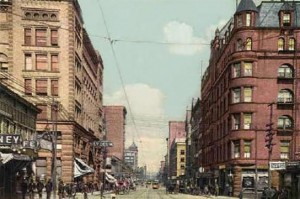 A couple of years ago, my mom, Collene Spencer, my sister, Cheryl Masterson, and I made a trip back to Superior, Wisconsin and Duluth, Minnesota to reconnect, and meet family members there. We had a wonderful trip, and both my sister and I have found sites on Facebook that display pictures of the area. Cheryl and I were both born in Superior, Wisconsin, so we feel a closeness to the area, even though we have not lived there for many years. It is still the area of our roots. Now that we have been back in a more recent time, a continue to feel drawn to the area. The strange thing is that the things I am interested in at this time, are more historic things…some of them, things that no longer exist. In my memory, we didn’t spend a lot of time in Duluth, but I’m probably mistaken on that count…at least to a degree. Superior, Wisconsin and Duluth, Minnesota are so close to each other, that if there were no signs to tell you so, you might not realize that you have left one and entered the other. I’m sure my parents shopped in Duluth, simply because as the larger of the two cities, there was quite likely more variety there.
A couple of years ago, my mom, Collene Spencer, my sister, Cheryl Masterson, and I made a trip back to Superior, Wisconsin and Duluth, Minnesota to reconnect, and meet family members there. We had a wonderful trip, and both my sister and I have found sites on Facebook that display pictures of the area. Cheryl and I were both born in Superior, Wisconsin, so we feel a closeness to the area, even though we have not lived there for many years. It is still the area of our roots. Now that we have been back in a more recent time, a continue to feel drawn to the area. The strange thing is that the things I am interested in at this time, are more historic things…some of them, things that no longer exist. In my memory, we didn’t spend a lot of time in Duluth, but I’m probably mistaken on that count…at least to a degree. Superior, Wisconsin and Duluth, Minnesota are so close to each other, that if there were no signs to tell you so, you might not realize that you have left one and entered the other. I’m sure my parents shopped in Duluth, simply because as the larger of the two cities, there was quite likely more variety there.
Recently, I started looking into some of the history of that general area, and stumbled on something 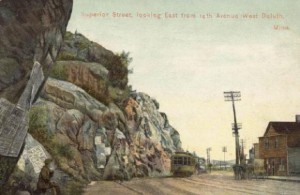 interesting. Duluth had an incline railway. Personally, I like incline railways, but I have never seen one that was in a city. Incline railways seem more like something that you would see at a tourist attractions, than anything that you would use in everyday life. Nevertheless, Duluth, in 1891, had a streetcar line, and in December 1891, the Duluth Street Railway Company opened the incline railway, as part of that street car line. The Incline Railway was on the right-of-way of Seventh Avenue West. The Duluth Street Railway Company had received a charter from the state in 1881 to build a streetcar line for Duluth. The hillside on Seventh Avenue West was too steep for a regular rail line, so they built an incline railway for that area. From it’s base station on Superior Street, the Incline climbed 509 feet in slightly more than half a mile, on a ten foot gauge track. Originally, a pair of forty one by fifteen foot cars counterbalanced each other, one going up while the other one descended. They were built to accommodate four teams and wagons, or up to 250 standing passengers. The Incline was powered by a stationary steam engine at the top. The trip took sixteen minutes, one way…just enough time to make it an enjoyable trip.
interesting. Duluth had an incline railway. Personally, I like incline railways, but I have never seen one that was in a city. Incline railways seem more like something that you would see at a tourist attractions, than anything that you would use in everyday life. Nevertheless, Duluth, in 1891, had a streetcar line, and in December 1891, the Duluth Street Railway Company opened the incline railway, as part of that street car line. The Incline Railway was on the right-of-way of Seventh Avenue West. The Duluth Street Railway Company had received a charter from the state in 1881 to build a streetcar line for Duluth. The hillside on Seventh Avenue West was too steep for a regular rail line, so they built an incline railway for that area. From it’s base station on Superior Street, the Incline climbed 509 feet in slightly more than half a mile, on a ten foot gauge track. Originally, a pair of forty one by fifteen foot cars counterbalanced each other, one going up while the other one descended. They were built to accommodate four teams and wagons, or up to 250 standing passengers. The Incline was powered by a stationary steam engine at the top. The trip took sixteen minutes, one way…just enough time to make it an enjoyable trip.
In 1925, it was noted that the Incline carried an average of 2,170 weekday passengers, while the connecting 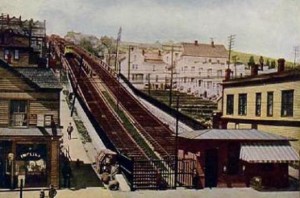 Highland streetcar line carried an average of only 1,114 weekday passengers. I’m sure that was because people like incline railways…they are unique….besides, climbing that hill would not be fun. Hourly checks showed that most riders traveled downhill in the morning rush hour and uphill during the afternoon rush hour. Most likely they were commuting to and from work. The Duluth Incline Railway was never profitable. Nevertheless, it and the Highland line were the last remnants of the streetcar system to be replaced by buses. Their last day of service was September 4, 1939. For that reason, I’m sure that many of the current residents of Duluth don’t even know about the incline railroad. I didn’t either, until I stumbled on it.
Highland streetcar line carried an average of only 1,114 weekday passengers. I’m sure that was because people like incline railways…they are unique….besides, climbing that hill would not be fun. Hourly checks showed that most riders traveled downhill in the morning rush hour and uphill during the afternoon rush hour. Most likely they were commuting to and from work. The Duluth Incline Railway was never profitable. Nevertheless, it and the Highland line were the last remnants of the streetcar system to be replaced by buses. Their last day of service was September 4, 1939. For that reason, I’m sure that many of the current residents of Duluth don’t even know about the incline railroad. I didn’t either, until I stumbled on it.

 During this journey to find my ancestors and my living family, there have been several times that I have felt that I had made a rare find. Of course, how could it be rare if there were several times, you might be thinking. I thought the same thing, and yet, some of the people I have come across have become so special to me that they could only be classified as a rare find. People like my father-in-law’s half brother, Butch Schulenberg, and our cousins Paul and Betty Noyes, come to mind immediately. But then, I also think of Tracey Inglimo, Denny Fredrick, Tim and Shawn Fredrick, Shirley Cameron, Pam and Mike Wendling, Bill and Maureen Spencer, and the many Schumacher cousins in
During this journey to find my ancestors and my living family, there have been several times that I have felt that I had made a rare find. Of course, how could it be rare if there were several times, you might be thinking. I thought the same thing, and yet, some of the people I have come across have become so special to me that they could only be classified as a rare find. People like my father-in-law’s half brother, Butch Schulenberg, and our cousins Paul and Betty Noyes, come to mind immediately. But then, I also think of Tracey Inglimo, Denny Fredrick, Tim and Shawn Fredrick, Shirley Cameron, Pam and Mike Wendling, Bill and Maureen Spencer, and the many Schumacher cousins in 
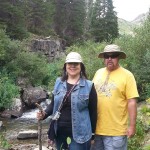 Wisconsin and Minnesota. I think of Nick and Laura Weber, and Joe Weber. As I think of these people, new rare finds and renewed rare finds, I begin to realize that as I have discovered these special people, some I have never met in person, and some that I have known all my life, but lost track of, I begin to realize that maybe rare finds in the family line aren’t really as rare as I thought they were after all.
Wisconsin and Minnesota. I think of Nick and Laura Weber, and Joe Weber. As I think of these people, new rare finds and renewed rare finds, I begin to realize that as I have discovered these special people, some I have never met in person, and some that I have known all my life, but lost track of, I begin to realize that maybe rare finds in the family line aren’t really as rare as I thought they were after all.
I have been thinking about what it is that makes a person a rare find, and the thing that immediately comes to mind is that these people truly care about me…about what I think and who I am. I find that these people are kindred spirits…something I had not really given much thought to until I got into the “Anne of Green Gables” 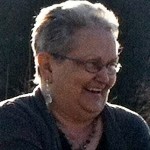
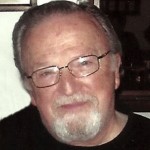 movies, but after watching those movies, I realize just how important kindred spirits really are. Kindred spirits share the same values, goals, and desires, even if they are is slightly different ways. I think it is the values though that mean the most. Maybe that is a big part of what makes these people a rare find. So much has changed in our world these days, and while we all have maybe a slightly different view of what things are wrong and how to fix them, I still find that these people are value driven people…patriots, who love this country and what it stands for.
movies, but after watching those movies, I realize just how important kindred spirits really are. Kindred spirits share the same values, goals, and desires, even if they are is slightly different ways. I think it is the values though that mean the most. Maybe that is a big part of what makes these people a rare find. So much has changed in our world these days, and while we all have maybe a slightly different view of what things are wrong and how to fix them, I still find that these people are value driven people…patriots, who love this country and what it stands for.
The longer I think about it, the more I realize that while finding people who compliment who I am is not such a rare find, it is still a 
 rare find that there are so many people who have become so very special to me. It warms my heart to think of these people, and it warms my heart with every conversation I have with them. It is my hope to someday meet those precious people who I have never had the pleasure of meeting in person. I know we will really hit it off, because we are family and kindred spirits. It’s a great combination. While my “rare finds” have not really been so rare after all, I am so blessed by each and every one of then, and that makes them absolutely priceless. I am very blessed to know them all.
rare find that there are so many people who have become so very special to me. It warms my heart to think of these people, and it warms my heart with every conversation I have with them. It is my hope to someday meet those precious people who I have never had the pleasure of meeting in person. I know we will really hit it off, because we are family and kindred spirits. It’s a great combination. While my “rare finds” have not really been so rare after all, I am so blessed by each and every one of then, and that makes them absolutely priceless. I am very blessed to know them all.
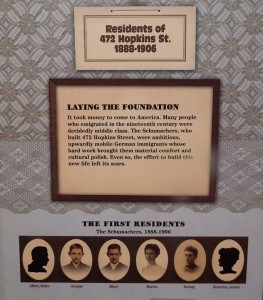 About a year ago, my cousin, Angie Schumacher Barden contacted me about a historic house that had been built by one Albert Schumacher and his family back in 1888, after they had moved from Henderson, Minnesota to Saint Paul, Minnesota. Angie wondered if these people might have been related to us. I told her that it would not surprise me, since Albert and Henrietta, who is his wife, are names that are in our family too. I expect that somewhere along the way, we will find that they are an aunt and uncle of some sort. I wish I could say that with this writing, I had found the connection, but I cannot say that yet. I have no doubt that in the near future I will find the connection, if it exists, but I have sometimes had to wait a long time, so you never know. Recently, Angie sent me pictures of the information she found at a museum, and I must say that I find it very interesting. The pictures tell not only that the Schumacher family built the house , but much of their family history, and it is from that information that my story will begin.
About a year ago, my cousin, Angie Schumacher Barden contacted me about a historic house that had been built by one Albert Schumacher and his family back in 1888, after they had moved from Henderson, Minnesota to Saint Paul, Minnesota. Angie wondered if these people might have been related to us. I told her that it would not surprise me, since Albert and Henrietta, who is his wife, are names that are in our family too. I expect that somewhere along the way, we will find that they are an aunt and uncle of some sort. I wish I could say that with this writing, I had found the connection, but I cannot say that yet. I have no doubt that in the near future I will find the connection, if it exists, but I have sometimes had to wait a long time, so you never know. Recently, Angie sent me pictures of the information she found at a museum, and I must say that I find it very interesting. The pictures tell not only that the Schumacher family built the house , but much of their family history, and it is from that information that my story will begin.
Albert and his wife, Henrietta arrived in Henderson, Minnesota in 1864. Their homeland was Germany. Now to my family, I’m sure you are beginning to see some similarities already. Albert had been trained as a confectioner in Germany, making him a really sweet guy in every sense of the word. When he arrived in Henderson, he saw he opportunity to to use those skills, so he opened up a sweet shop. He later worked for several years in the store of a merchant named Henry Poehler. He became the proprietor of the Sibley County Saloon in 1878, when Lorenz Oberst agreed to sell it to him. In 1888, decided to move his family to Saint Paul, Minnesota, where they opened up Schumacher’s Pharmacy. He had wanted to move for some time, and finally found a buyer for the saloon in one, Charles Pruetz.
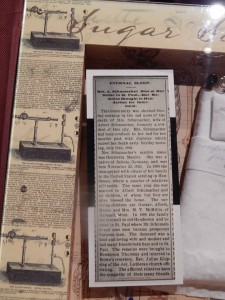
Albert and Henrietta, and the two of them had welcomed six children into the world. Joyous events to be sure, but into each life some rain must fall, and they were no exception. Of their six children, only Gustav, Albert, Margaret, and Hedwig survived. Arthur died at nine months and Camilla died after only ten days. Those were hard times for the family, but they had to go on for the other children.
Once they moved to Saint Paul, Albert and his sons built the house at 472 Hopkins Street. The family lived there from 1888 to 1906. On July 15, 1894 the family would again experience loss, when Albert’s beloved wife, Henrietta passed away. While Albert stayed in the house for six more years, I doubt if those last years were at all as happy as the first years had been. I’m sure that if those walls could talk, they would have many stories to tell about the years the family spent there. I look forward to learning more about this amazing family, and to find out for sure, if they are related to us.

 There is a popular song by Miranda Lambert called “The House That Built Me.” It is a rather bittersweet song about visiting the house where she grew up, in and effort to find herself again. I suppose that it is very common to lose sight of self as the years go by, and life gets busier and busier. Sometimes we just find ourselves needing to regroup, to a degree. Of course, in the song, she really just wanted to get back in touch with her beginnings. I can understand that, since my sister, Cheryl Masterson, my mom Collene Spencer, and I took a trip back to Superior, Wisconsin, to reconnect with family members, the town, and the house where the first years of my life were spent. Of course, unlike Miranda Lambert, we didn’t ask to go into the house, although it might have been fun to do so, and unlike Miranda, I didn’t grow up in the house, but rather the first couple of years of my life. Nevertheless, standing there in front of the house, I found myself thinking about the home movies I had seen of our time there. They were good memories, and it felt good to be there to see that house that represented my beginning.
There is a popular song by Miranda Lambert called “The House That Built Me.” It is a rather bittersweet song about visiting the house where she grew up, in and effort to find herself again. I suppose that it is very common to lose sight of self as the years go by, and life gets busier and busier. Sometimes we just find ourselves needing to regroup, to a degree. Of course, in the song, she really just wanted to get back in touch with her beginnings. I can understand that, since my sister, Cheryl Masterson, my mom Collene Spencer, and I took a trip back to Superior, Wisconsin, to reconnect with family members, the town, and the house where the first years of my life were spent. Of course, unlike Miranda Lambert, we didn’t ask to go into the house, although it might have been fun to do so, and unlike Miranda, I didn’t grow up in the house, but rather the first couple of years of my life. Nevertheless, standing there in front of the house, I found myself thinking about the home movies I had seen of our time there. They were good memories, and it felt good to be there to see that house that represented my beginning.
My great aunt, Bertha Schumacher Hallgren and her sister, Elsa Schumacher Lawrence had the opportunity as teenagers to travel from their home in Fargo, North Dakota, to Minnesota. While there, they were not only able to see the house where they were born, but the actual room they were born in. Things are much different these days. Most people are born in a hospital, rather than at home, so we don’t necessarily think of the room we were born in, because there is almost no way to know exactly which one it was years later. Bertha and Elsa had such an amazing opportunity…one I suppose many of us might envy, if we thought about it very long. The time they lived in, combined with the kindness of the new owners, allowed them to take a small glimpse into their past. It was an event that affected Bertha so much, that she wrote about is years later. She too, had been a young girl when the family moved away, but unlike me, she was able to step back into the world, and feel what it was like in those early years.
No, I suppose you can’t really go home again, unless like my younger sisters, your parents stayed is the house where you grew up. In that case, while you have grown up, married, or moved out on your own, you still have 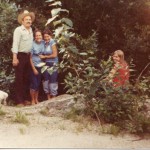
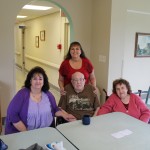 those close ties to the home of your youth, and with it, the memories and values you grew up with. Yes, my older sister, Cheryl and I do have those memories too, we have still found ourselves wondering what our lives would have been like, and who we would have been if our parents had stayed in Wisconsin. I know things would have been different for sure, but in reality, all the changes that have gone on in our lives have turned out to be the best life for us anyway. So maybe, going back to a lost childhood home really makes little difference in the grand scheme of things afterall.
those close ties to the home of your youth, and with it, the memories and values you grew up with. Yes, my older sister, Cheryl and I do have those memories too, we have still found ourselves wondering what our lives would have been like, and who we would have been if our parents had stayed in Wisconsin. I know things would have been different for sure, but in reality, all the changes that have gone on in our lives have turned out to be the best life for us anyway. So maybe, going back to a lost childhood home really makes little difference in the grand scheme of things afterall.
 While Bob and I were in San Francisco a number of years ago, we had the opportunity to ride the cable cars there. Cable cars, or trolley cars are pretty much a novelty in most places, but they used to be pretty commonplace. There are still many cities that operate a modern day version of the cable car, which is reality is more like a inter-city train than a cable car. But, the traditional cable car, street car, or trolley car were really very different from their modern day cousins, and the ride on the older version was really a lot of fun. Many cities had cable car systems that few people even remember. New York for example, has a huge subway system, but this came to be after the trolley system became problematic. Now, the old trolley system is just a faint memory, and in reality, one that is not very well known.
While Bob and I were in San Francisco a number of years ago, we had the opportunity to ride the cable cars there. Cable cars, or trolley cars are pretty much a novelty in most places, but they used to be pretty commonplace. There are still many cities that operate a modern day version of the cable car, which is reality is more like a inter-city train than a cable car. But, the traditional cable car, street car, or trolley car were really very different from their modern day cousins, and the ride on the older version was really a lot of fun. Many cities had cable car systems that few people even remember. New York for example, has a huge subway system, but this came to be after the trolley system became problematic. Now, the old trolley system is just a faint memory, and in reality, one that is not very well known.
In fact, problematic was maybe an understatement when it comes to reality concerning the cable car system. Once the automobile became a common item in the American household, there were a number of incidences involving the automobile and the trolley 
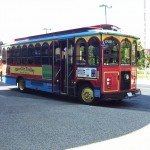 or cable car. I’m sure you can guess who won that battle. The trolley or cable car was bigger, and it was after all, limited as to where it could operate, while the automobile was free to go where it chose…pretty much anyway. Nevertheless, there were collisions between the two forms of transportation…as well as traffic jams at times. Eventually, with automobiles becoming so commonplace, the trolley or cable car began to go by the wayside…Finally ending up as the novelty it is today.
or cable car. I’m sure you can guess who won that battle. The trolley or cable car was bigger, and it was after all, limited as to where it could operate, while the automobile was free to go where it chose…pretty much anyway. Nevertheless, there were collisions between the two forms of transportation…as well as traffic jams at times. Eventually, with automobiles becoming so commonplace, the trolley or cable car began to go by the wayside…Finally ending up as the novelty it is today.
When my daughter, Corrie Petersen and I were in Minneapolis in August of 2005, we had the opportunity to take a city tour on an old trolley car. Of course this one was of the variety that had come out when the automobile came out. It needed no cable, but was rather a trolley car bus, I suppose. The seats and the windows were definitely authentic trolley car though. The tour was a lot of fun…probably mostly because it was a novelty trip. Bob and I had an additional opportunities in Alaska, on a tour of Anchorage. I really like the 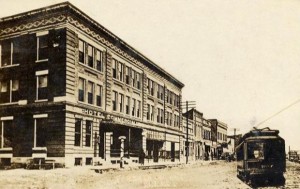 trolley car tours.
trolley car tours.
The other day I was looking at some old pictures of Montana history, and I came across something about Forsyth that I didn’t know about before. The little town of Forsyth, population about 1400 people in 1914, with one maim street is a place that you can easily walk across in just a few minutes. Nevertheless, the little town of Forsyth, Montana had a cable car in 1914, so people could ride the length of that main street…probably eight to twelve blocks. I was amazed to learn of that little tidbit of Forsyth history, which was the place where many of Bob’s family members lived, and where many still live today.

![10592837_10203606798789446_4580093225917977156_n[1]](https://carynschulenberg.com/wp-content/uploads/2015/05/10592837_10203606798789446_4580093225917977156_n1-150x150.jpg) Last night, while my sister, Cheryl Masterson and I were going through several boxes of our parents paperwork to prepare it for shredding, we came across a number of letters from different family members. I was drawn to some from my dad’s brother, William Spencer. One letter was written on March 5, 1990, and told a lot about the small town of Holyoke, Minnesota, where the family lived for a number of years. Uncle Bill talked of how the town was just a skeleton now, and so unlike its former self. I could read the sadness in his thoughts. Holyoke was a place that, in his childhood, had seemed larger than life. He knew every inch of it. He and my dad, their sister, Ruth, and their friends had dodged the trains, played ball, gone to school, fished the stream, and…well, lived life there. Uncle Bill was sad, because now, all that was changing.
Last night, while my sister, Cheryl Masterson and I were going through several boxes of our parents paperwork to prepare it for shredding, we came across a number of letters from different family members. I was drawn to some from my dad’s brother, William Spencer. One letter was written on March 5, 1990, and told a lot about the small town of Holyoke, Minnesota, where the family lived for a number of years. Uncle Bill talked of how the town was just a skeleton now, and so unlike its former self. I could read the sadness in his thoughts. Holyoke was a place that, in his childhood, had seemed larger than life. He knew every inch of it. He and my dad, their sister, Ruth, and their friends had dodged the trains, played ball, gone to school, fished the stream, and…well, lived life there. Uncle Bill was sad, because now, all that was changing.
Uncle Bill wrote of the passing of this friend, and that friend, as well as all the citizens, teachers, parents, and business owners who had lived in the little town of Holyoke. While the passing of the people he knew and loved was hard enough, the loss of the different buildings in the town was equally devastating to my dear Uncle Bill. I think the building that was the hardest for him to see go was the little church, which held the baptismal font that had been built in 1935 by Fritz Fredrick, who is the father of my cousins Gene and Dennis Fredrick. Fritz also did most of the cabinet work, too. It was very hard for Uncle Bill to think of that baptismal font being left to rot, so he bought it and gave it to one of Fritz’s sons. Uncle Bill writes about how sad it makes him to see the buildings delapitated and, in his words, forlorn. Nevertheless, he continues to be drawn to Holyoke because it feels like going home to him. He loves the people there, and loves to spend time visiting with them. Holyoke is and always will be a part of him…like it’s in his DNA.
Uncle Bill’s letter continues to draw me back to it in much the same way that Holyoke draws Uncle Bill back to ![10342804_10203606793869323_3232942561128602595_n[1]](https://carynschulenberg.com/wp-content/uploads/2015/05/10342804_10203606793869323_3232942561128602595_n1-150x150.jpg)
![10624963_10203606795149355_518549074166794281_n[1]](https://carynschulenberg.com/wp-content/uploads/2015/05/10624963_10203606795149355_518549074166794281_n1-150x150.jpg) it, because even if the feelings are raw and painful to a degree, it is harder not to make the trip than it is the deal with the feelings when you go back there. My mom, Collene Spencer, my sister, Cheryl Masterson, my cousin Bill Spencer (Uncle Bill’s son), and I visited Holyoke this past August while we were back in Superior, Wisconsin, and I can completely understand how Uncle Bill feels about that place. I don’t recall having been there before, but like my Uncle Bill, Holyoke, Minnesota will continue to live in my heart. I guess that some places simply have that affect on you.
it, because even if the feelings are raw and painful to a degree, it is harder not to make the trip than it is the deal with the feelings when you go back there. My mom, Collene Spencer, my sister, Cheryl Masterson, my cousin Bill Spencer (Uncle Bill’s son), and I visited Holyoke this past August while we were back in Superior, Wisconsin, and I can completely understand how Uncle Bill feels about that place. I don’t recall having been there before, but like my Uncle Bill, Holyoke, Minnesota will continue to live in my heart. I guess that some places simply have that affect on you.

